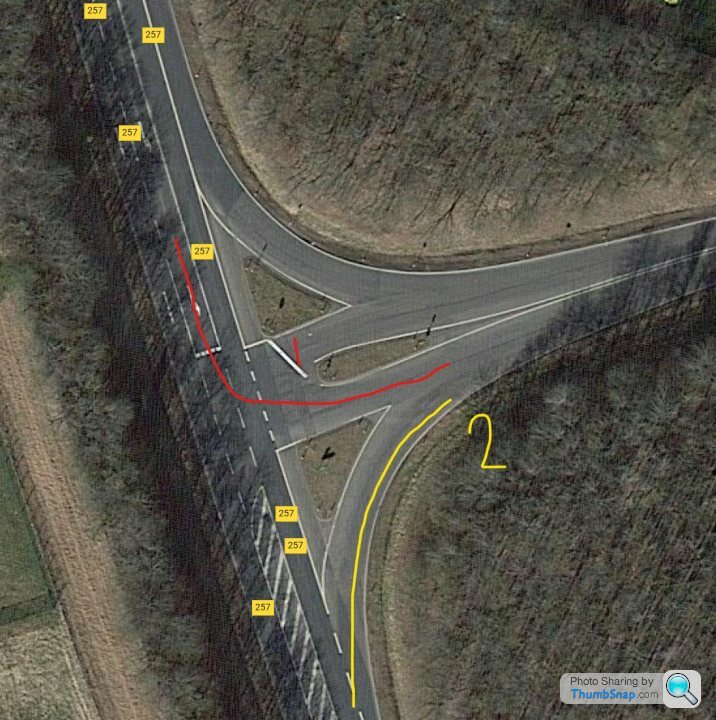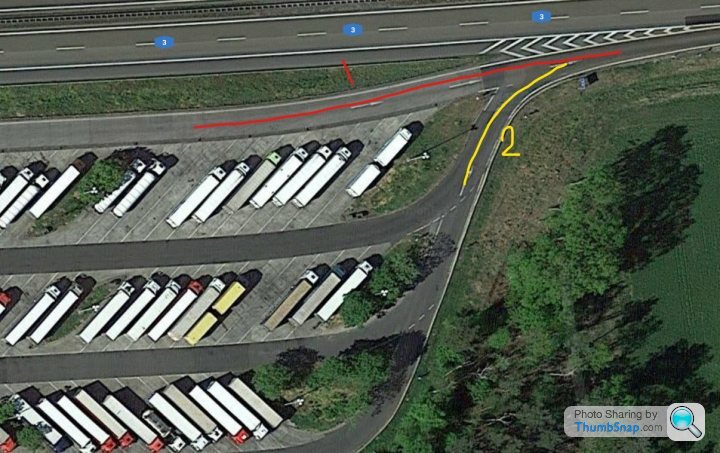Understanding priority to the right in Europe with examples
Discussion
Hi all,
I've done a fair few miles in continental Europe but there are some things I am looking to clarify surrounding priority to the right (right before left) to ensure I understand it. I've never come across a practical problem, but I'd rather know than not know in case I am doing something wrong. I've listed some examples below of stuff I am not 100% sure about, and I would like to hear how people think I should approach these situations.

My interpretation is that 2 has priority over 1, at least in theory. That is because there is no markings or signs that would otherwise signify a yield for traffic from 2. Obviously 1 has to yield to oncoming traffic on the main same road. Who really has the priority?

This is a little more unclear to me. I interpret all of this to be a parking place, and therefore 2 would conventially take priority. However, traffic on 1 likely will be going faster and getting ready to match speed of the highway. In addition, it looks like there may be a yield sign for traffic from 2 based on the shadow cast. From memory, not all service station have a yield sign like this, so how should we deal with priority in such a case?
These questions may be silly and have obvious answers, but I'd rather understand it. In fact, it's even embarrassing asking.
Thanks in advance.
I've done a fair few miles in continental Europe but there are some things I am looking to clarify surrounding priority to the right (right before left) to ensure I understand it. I've never come across a practical problem, but I'd rather know than not know in case I am doing something wrong. I've listed some examples below of stuff I am not 100% sure about, and I would like to hear how people think I should approach these situations.
Example 1
The first example is from here.
My interpretation is that 2 has priority over 1, at least in theory. That is because there is no markings or signs that would otherwise signify a yield for traffic from 2. Obviously 1 has to yield to oncoming traffic on the main same road. Who really has the priority?
Example 2
The second example is from here - a motorway service station.
This is a little more unclear to me. I interpret all of this to be a parking place, and therefore 2 would conventially take priority. However, traffic on 1 likely will be going faster and getting ready to match speed of the highway. In addition, it looks like there may be a yield sign for traffic from 2 based on the shadow cast. From memory, not all service station have a yield sign like this, so how should we deal with priority in such a case?
These questions may be silly and have obvious answers, but I'd rather understand it. In fact, it's even embarrassing asking.
Thanks in advance.
I’ve driven across Europe four times in the last year. It’s generally a pleasure with higher driving standards and less traffic than over here =though lets exclude Belgium and bits of Italy from that generalisation.
What I loathe, and loathe with a passion, is Priorite a droit. It still fills me with dread.
As far as I understand it, there are two things to watch for. Firstly, when you see the yellow square with a line through it, that means you are no longer on the priority road and priorite a droit now applies. Secondly, if a junction has no markings across the side road, then it applies.
In areas where it applies, it is universal. No matter how minor the side road, how stupid it appears that such a road would have the priority over you, if there are no markings on the junction then the traffic on the right always has the right of way.
What I loathe, and loathe with a passion, is Priorite a droit. It still fills me with dread.
As far as I understand it, there are two things to watch for. Firstly, when you see the yellow square with a line through it, that means you are no longer on the priority road and priorite a droit now applies. Secondly, if a junction has no markings across the side road, then it applies.
In areas where it applies, it is universal. No matter how minor the side road, how stupid it appears that such a road would have the priority over you, if there are no markings on the junction then the traffic on the right always has the right of way.
Your examples are correct but priority applies only if it is not marked by a stop or give way sign and on your examples, it would be marked.
The absolutely most important sign to observe is a yellow diamond which means you are on a priority road and that traffic entering from the right has to give way. A yellow diamond with a black stripe through it means that you now have to give way to the right. Intersections where priority is given to the right are marked by a St Andrew’s cross “X” in a red triangle and those where you have priority are marked with a St. Mark’s cross “+”, as in the UK. Unless you are in the middle of nowhere, a yield line will also be painted across the road ahead. As the previous poster said, traffic on a roundabout always has priority.
There are two advantages of priority on the right. The main one is to slow urban traffic down and it is very effective. The other is that traffic lights can be switched to flashing amber at night. When this happens, there is always a yellow diamond or a St. Andrew’s cross mounted above the lights. So you know what to do.
Don’t forget the diamonds and you’ll be fine.
The absolutely most important sign to observe is a yellow diamond which means you are on a priority road and that traffic entering from the right has to give way. A yellow diamond with a black stripe through it means that you now have to give way to the right. Intersections where priority is given to the right are marked by a St Andrew’s cross “X” in a red triangle and those where you have priority are marked with a St. Mark’s cross “+”, as in the UK. Unless you are in the middle of nowhere, a yield line will also be painted across the road ahead. As the previous poster said, traffic on a roundabout always has priority.
There are two advantages of priority on the right. The main one is to slow urban traffic down and it is very effective. The other is that traffic lights can be switched to flashing amber at night. When this happens, there is always a yellow diamond or a St. Andrew’s cross mounted above the lights. So you know what to do.
Don’t forget the diamonds and you’ll be fine.
Gassing Station | Advanced Driving | Top of Page | What's New | My Stuff



